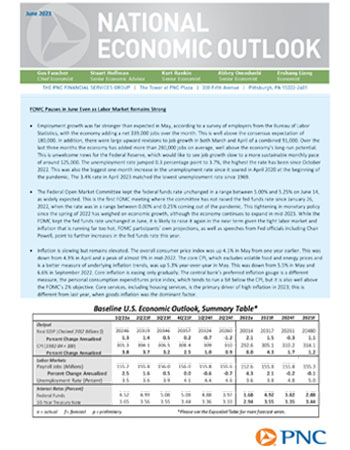The information contained in this site, is to the best of PNC Bank's knowledge, correct and accurate, but PNC Bank does not represent, warrant or guarantee its accuracy. Any downloading of material contained in this site or of any site linked to this site may be a violation of federal trademark and copyright laws.
PNC National Economic Outlook
June 2024
Fed Signals Rate Cuts Later This Year as Expansion Continues in Mid-2024
As expected, the Federal Open Market Committee kept the federal funds rate unchanged in its policy statement on June 12, in a range between 5.25% and 5.50%.
After rapidly cutting the fed funds rate to essentially zero in the aftermath of the pandemic, the FOMC increased the fed funds rate to its current level from early 2022 to mid-2023. This FOMC meeting included the release of the Summary of Economic Projections (SEP), or “dot plot.”
According to the dot plot, four FOMC participants expect no cut in the fed funds rate this year, seven expect one 25 basis-point cut, and eight expect a cumulative 50 basis-point cut this year (presumably two 25 basis-point cuts). This is a change from the previous dot plot, on March 20, when the committee was about evenly divided between three or more cuts (10 participants) and two or fewer cuts (9 participants).
The June 12 SEP had the median fed funds rate at 4.1% at the end of 2025, up from 3.9% in the March SEP, suggesting four 25 basis-point rate cuts next year. In his post-meeting press conference, Federal Reserve Chair Jerome Powell noted that fifteen of the FOMC participants were clustered around one or two rate cuts this year, indicating that the FOMC does expect to cut the fed funds rate in 2024.
The U.S. economy added 272,000 jobs in May, according to a survey of employers from the Bureau of Labor Statistics. There was a combined downward revision to employment in March and April of 15,000. Over the past three months the U.S. economy has added an average of 250,000 jobs per month, the same pace as in all of 2023.
After 27 straight months of being below 4%, the unemployment rate increased slightly in May to 4.0%, from 3.9% in April and 3.8% in March. The labor force participation rate, the share of adults in the labor force, fell to 62.5% in May from 62.7% in April. The labor force participation rate has been consistently below the pre-pandemic 63%+ rate, contributing to the ongoing tight labor market.
Average hourly earnings rose 0.4% in May from April, after a 0.2% increase in April. On a year-ago basis average hourly earnings were up 4.1% in May, an acceleration from 3.9% growth in April. This pace of wage growth is somewhat higher than is consistent with the Fed’s 2% inflation target.
Real GDP increased 1.4% at an annualized rate in the first quarter of 2024, according to the third estimate from the Bureau of Economic Analysis. Growth was reported at 1.6% in the advance estimate, and 1.3% in the second estimate. (The third estimate was released after PNC prepared its June forecast.) Real GDP growth slowed from a 3.4% increase in the fourth quarter of 2023 and 4.9% in the third quarter.
Economic growth in the first quarter came from solid gains in consumer spending, business fixed investment, investment in housing, and government. Trade and inventories were drags on growth in the first quarter. Real final sales of domestic product—GDP minus the change in inventories, which measures demand for U.S.-produced goods and services—rose 1.8% annualized in the first quarter.


